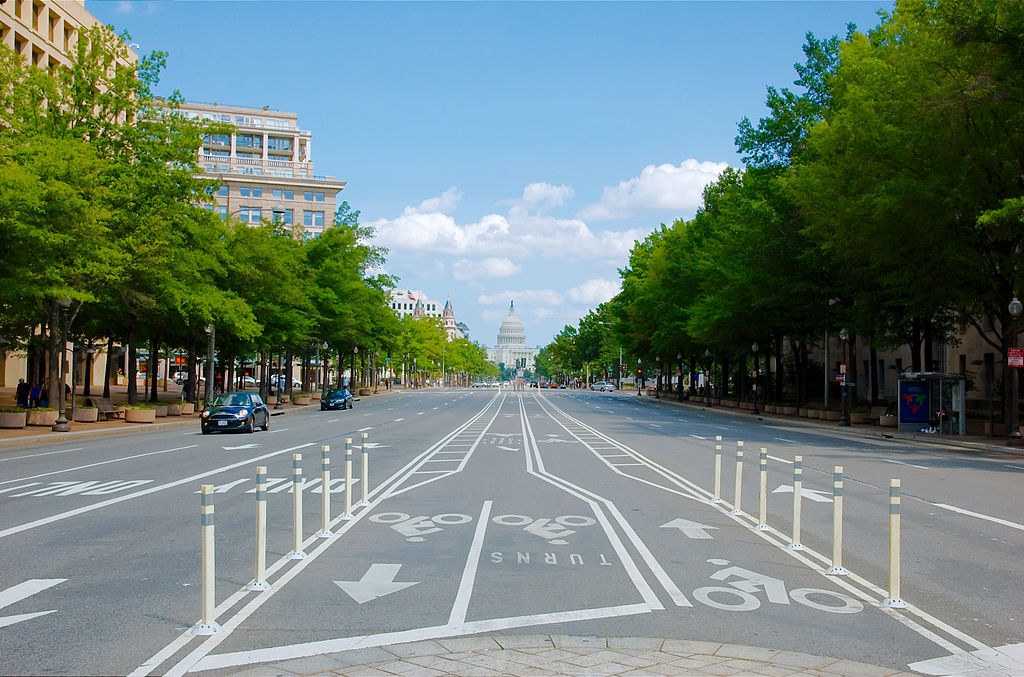Trump's Military Parade: Pennsylvania Avenue is Not Red Square
On Feb. 6, the Washington Post reported that President Trump has instructed the Defense Department to plan a large military parade in Washington on a major holiday. Presumably, the president would attend and review the troops.

Published by The Lawfare Institute
in Cooperation With

On Feb. 6, the Washington Post reported that President Trump has instructed the Defense Department to plan a large military parade in Washington on a major holiday. Presumably, the president would attend and review the troops. The administration presents the parade as a way to honor the military. The president was impressed by France’s Bastille Day parade and wants to top it.
Trump’s interest in presiding over a massive public display of military force appears, however, to predate his visit to Paris. His presidential transition team reportedly pushed for a “Red Square / North Korea-style” inaugural parade complete with waves of troops, tanks and missile launchers, but were rebuffed by an uncomfortable Pentagon. Discomfort within the military persists. Former intelligence officers who are all too familiar with mass military parades in authoritarian states and what those parades represent are unsettled, too. Among veterans, and in the country more generally, opinion is mixed. Some love most anything Trump does or like the idea of honoring the military. Others in and out of uniform are concerned about prop-like use of the military in an inevitably controversial presidential event.
A parade is a public spectacle and civic statement. As a symbolic event, it would be easy to make too much or too little of the proposed big parade.
There are, however, good reasons why the president should be counseled to avoid making Pennsylvania Avenue look anything like Red Square. If necessary, Congress could prohibit the President from using the U.S. military here at home in a way that would violate important American norms and—to those worldwide who fight for liberty—telegraph familiar and dispiriting authoritarian messages of intimidating state authority, military supremacy, and the fealty of the saluting armed forces to the great leader on the reviewing stand.
First, such a parade would violate a longstanding American civil-military tradition against large displays of military power in civilian settings. This norm is grounded in the foundational counter-authoritarian ethos of our Constitution and nation, and in the longstanding commitment of the American military to being non-political and subordinate to civilian authority under the rule of law. Accordingly, our history has largely reserved massive domestic public military displays to singular moments of national celebration at the triumphant conclusion of major wars. In the last century, there have been only three parades on the scale the White House evidently contemplates. They came on the heels of successful ends to World War I, World War II, and the Persian Gulf War. We are not at an analogous moment. More than 16 years after 9/11, the United States regularly uses force against terrorist networks in more than a half-dozen countries, with no end to the war in sight. The Islamic State has suffered major setbacks in Syria and Iraq, but along with other terrorist organizations, it has been metastasizing and franchising globally, not surrendering. The intelligence community predicts continued attacks and insurgency abroad. Other experts warn that the threat to the West will endure and may grow.
Second, a Red Square-style parade in America would send the wrong signal to the world at the wrong time. A quarter century after democracy’s apparent triumph in the Cold War, China and Russia are trying to sell the world on the propositions that American democracy, ideals, and traditions do not work, and that militaristic authoritarian regimes running crony-capitalist economies are the future. Republics from Turkey up through Eastern Europe are sliding into illiberal—i.e., increasingly authoritarian—democracy. With a national security interest in the global progress of liberty, it is not in our interest to see American troops ordered to participate in a spectacle that to much of the world would look like parades in the Soviet Union, Nazi Germany, Fascist Italy, Russia today, and a host of other dictatorships including North Korea.
A third compelling reason to shelve the parade plan is that it would be unhelpful at a worrisome moment in civil-military relations.
The Trump administration’s first year has seen disruption of long-standing traditions concerning the relationship between the president and the armed forces, and unusual discomfort with the Commander in Chief. The highly political speeches that President Trump has delivered to compulsorily-attending and compulsorily-clapping military audiences have been an especially unwelcome development. Trump speaks in proprietary terms of “my generals,” and has appointed an unusual number of current and retired general officers to top civilian positions. Last summer, the president suggested he was acting at military recommendation when he announced on Twitter a ban on service by transgender Americans, only to be met by remarkable public statements from the nation’s most senior military officers distancing the military from the Commander-in-Chief’s comments. The president’s major announcement had plainly not gone through the regular military policy development process, and was followed by months of Pentagon bureaucratic churn and study rather than quick implementation. The trajectory of this matter fits a broader pattern of civil-military relations under Trump, as Phillip Carter described in Lawfare. Meanwhile, if during the last half year you have spent more than 10 minutes in frank conversation with military officers in the wake of the president’s threats and taunts regarding North Korea, chances are you heard an unusual level of concern within the ranks about whether a U.S. president is being cavalier about war and nuclear weapons.
What is needed today is a thoughtful effort by the president and other public officials to restore civil-military norms. In this context, bootstrapping U.S. service members into a sensational and inherently political spectacle that further personalizes the president’s relationship with the armed forces is not constructive. Many troops will be enormously uncomfortable. Indeed, a recent poll shows opinion regarding the parade divided 44 percent in favor and 32 percent opposed among troops and their families, a 44-42 split among veterans, and the country as a whole 35-45 against the parade. With national emotions already running high, a controversial parade—already debated as “honoring the military” versus “Trump playing generalissimo”—risks drawing our armed forces ever-deeper into the fever swamps of today’s overheated political culture. A more politicized military is a disturbing prospect in an age in which public regard for other civil institutions has cratered. Courts, the Congress, religion, newspapers, public schools, medical professionals—all of them have been discredited in the eyes of a large number of Americans. This is an alarming sign that in a time of persistent national insecurity the people are doing something of which Alexander Hamilton warned in The Federalist No. 8: placing their faith in national security institutions that protect but also inherently imperil liberty. (And indeed, although they remain minorities, the percentages of Americans open to military rule or authoritarian rule have grown significantly in recent years. For example, the proportion of polled Americans who believe it is better to have a “strong leader” who doesn’t have to “bother with [Congress] and elections” rose from roughly one-fourth in 1995 to nearly one-third in 2011). This is a moment for repairing civil-military norms and for buttressing the military’s separateness from politics, not for drawing our professional armed forces further into the hyper-partisan fray.
The president’s advisers, civilian and military, should counsel him against the parade. If the requests continue, Congress could enact a standing “Anti-Red Square” statute not specific to any president. It could prohibit (1) display or parade of military forces involving more than 200 or so personnel, more than a handful of ground combat vehicles, and/or more than a dozen aircraft, (2) in a public place, (3) attended by the president and/or vice president, (4) absent explicit authorization in law by Congress for that specific parade. (Small ceremonial formations at formal presidential events, and larger training and ceremonial formations on military installations, are traditional and would be fine.) The administration may well protest on political or separation of powers grounds. Congress could without question, however, bar funds for military displays inconsistent with these requirements. Under an underappreciated congressional national security power I explore in a forthcoming article, Congress arguably could also enact these restrictions as constitutional “Rules for the Government and Regulation of the land and naval Forces.”
Like many Americans, I could not believe more strongly that the armed forces deserve our gratitude. Our military personnel, families, and veterans have achieved and sacrificed so much for our country. Thankfully, there are innumerable ways to honor the troops that do not involve imitating the parades of repressive regimes our armed forces have stood against. These include welcome-home and holiday parades for the troops in cities and towns attended by state and local officials, social events by communities that are home to military installations, and other acts of public recognition of particular troops and units by citizens and government. Businesses can expand discounts for military personnel and veterans. Americans in their personal lives can provide love and support to military families and veterans in our communities. The president can honor the troops in a wide variety of traditional and important ways, from awarding medals, to public speeches, to hospital visits and meals with wounded troops, veterans, and their families. The president and Congress can also honor the military’s mission—defending the nation—by devoting the $30 million a parade would cost to pressing military operations, maintenance, procurement, personnel, and veteran-related expenses.
Ultimately, punting the big parade would reflect the counter-authoritarian constitutional ethos and vital civil-military norms that have helped make America great. We should be a shining example of healthy civil-military relations, not a new adopter of the intimidating symbols of the world’s worst oppressors. Pennsylvania Avenue should continue to be a welcoming civilian space. It should not be a place that gives many Americans—including many U.S. troops—the disturbing feeling that they have entered an American Red Square.



.png?sfvrsn=48e6afb0_5)

